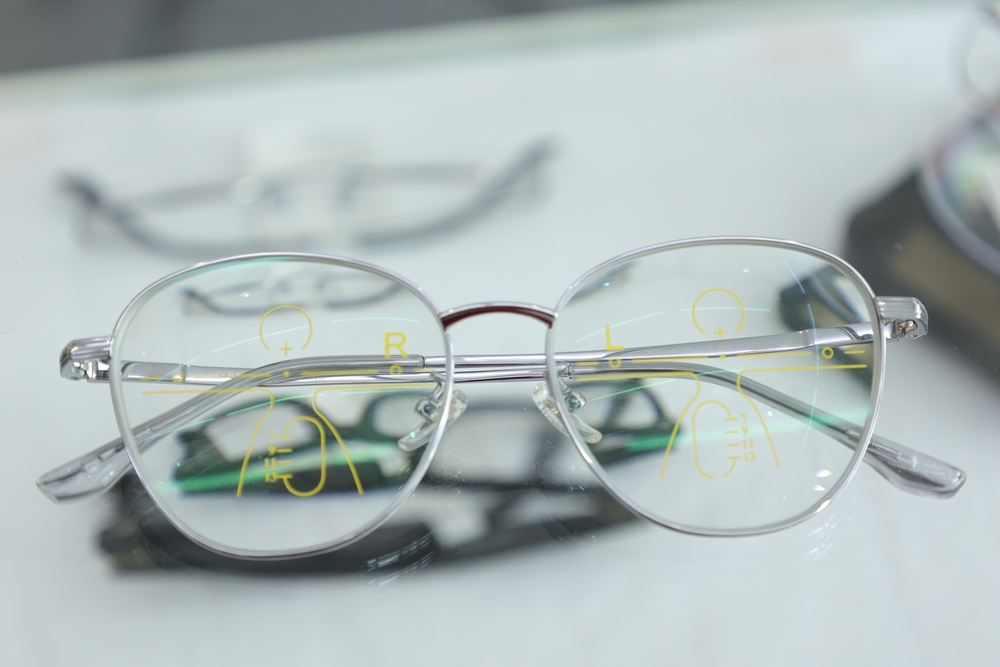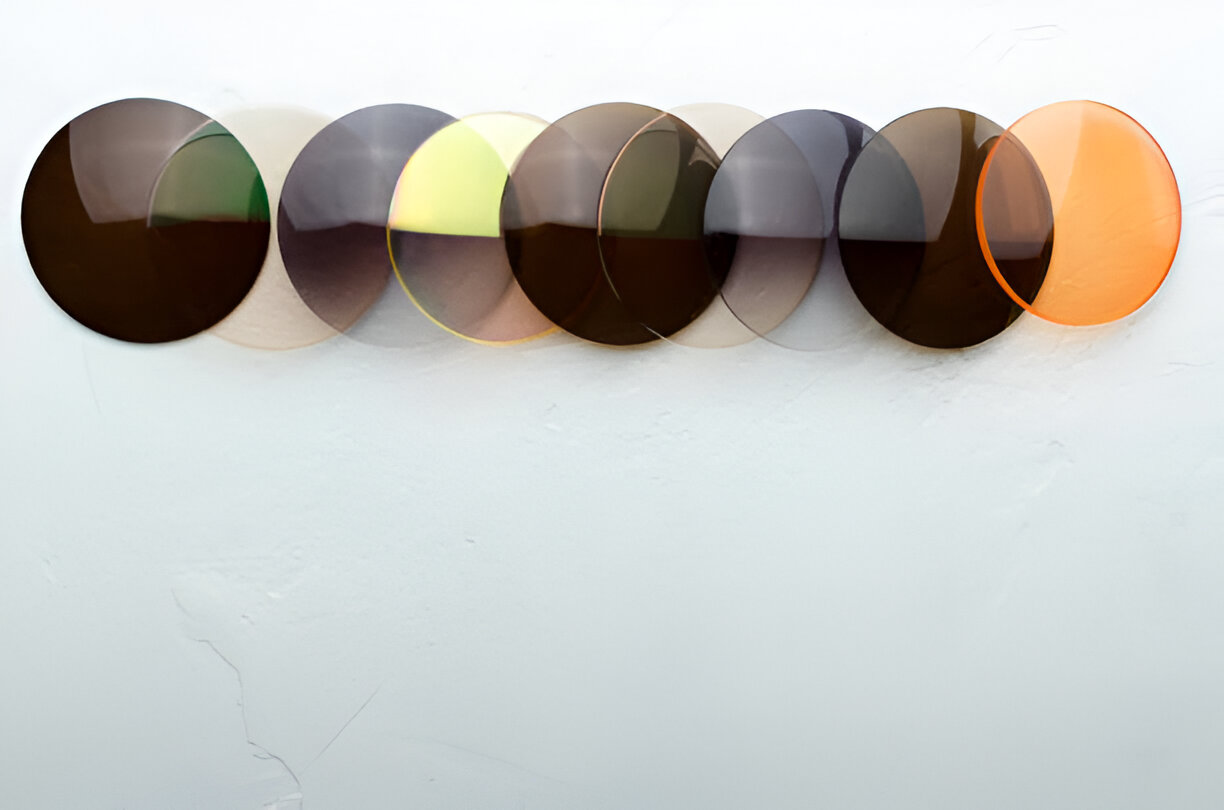
Blog
Progressive Lenses: How To Tell If They Are Correct
Progressive lenses do not have conventional lines of bifocals or trifocals but instead, provide a multifocal optical solution. These lenses offer a gradient of vision correction with reading correction at the lower part and distance correction at the top for people with presbyopia or those who require support with both close and distant vision. Correct fitting of these lenses is essential for the best visual comfort and performance. When progressive lenses are fitted properly, one should be able to see clearly at all distances. Sharp vision should be observed in the distance when gazing directly ahead. The close-up vision should focus as the gaze descends naturally, without requiring any postural corrections or head tilts.
The presence of blurriness or the necessity to maintain the head in an awkward position may indicate that the fit is not quite right. It's also crucial to make sure your peripheral vision is still unobstructed. Progressive lenses may initially create some distortion, and they need to be adjusted for a while. Nonetheless, this effect ought to be negligible with a proper fit, and the wearer ought to get used to shifting their eyes—rather than their head—to focus on other locations fast. To make sure progressive lenses function as intended, routine eye exams and expert adjustments with an eye care professional are essential.
Comprehending Progressive Lenses
With the multi-focal solution provided by progressive lenses, one may see clearly at different ranges without requiring additional glasses. Progressive lenses are multi-focal optical lenses that offer a seamless transition between top-to-bottom near- and distance-correction. They are designed for those who have presbyopia, an age-related disorder that impairs the eye's capacity to focus on near objects. With one pair of prescription glasses for all distances, these lenses seek to do away with the necessity for numerous pairs.
Features of the Progressive Lenses Design
Progressive lens designs include several important zones:
- The distance zone is the area of the lens that is most suited for viewing distant things.
- The intermediate zone helps with vision clarity at intermediate distances, like the range of a computer screen.
- Reading material and other close-up objects are visible to the wearer due to the lens's lower part which is called a near zone.
The lack of visible lines dividing the zones is a unique trait of single-vision lens safety glasses, offering an aesthetic advantage over conventional bifocals or trifocals. For optimal visual clarity and comfort, these zones have to be precisely positioned about the wearer's eyes.
An Initial Evaluation of Progressive Lenses
A person should assess two important factors when they get new progressive lenses: the lens fitting on their faces and the visual clarity at different distances.
- Visibility: Visual Consistency and Clarity at Various Distances: It is critical to guarantee clarity at close-up, mid-range, and far-off perspectives. If, through the proper sections of the lenses, one perceives blurry images at any of these distances, the lenses may need to be adjusted.
- Distance Section: Examine an object in the distance to assess the clarity in the upper portion of the lenses.
- Intermediate Section: Try observing items at arm's length to evaluate the intermediate portion of the lenses.
- Near Section: Consider which area is best for reading or performing chores that require close inspection.
- Check Your Peripheral Vision: Clear peripheral vision is another benefit of progressive lenses. The lenses may need to be realigned if you can see fuzzy edges when gazing straight forward.
- Appropriate Lens Fit and Comfort: The safety glasses frames should be tight but not too tight over the ears and temples, and the lenses should rest pleasantly on the nose. There shouldn't be any soreness or the necessity for him or her to continually reposition the glasses. He or she shouldn't be in any pain or need to keep adjusting the glasses all the time.
- Comfortable Head Posture While Viewing: To avoid uncomfortable head tilting, the wearer should keep their head in a natural posture for various jobs. For instance, to read or to notice distant objects, one shouldn't have to raise their chin excessively. If such modifications are necessary, it is usually a sign that the lenses are not positioned correctly or that the segment heights are out of alignment.
Typical Signs of Improper Lenses
The change from far-to-close vision should be smooth with progressive lenses. The efficacy of the lenses may be diminished by improperly fitted lenses, which frequently cause physical pain or visual distortions.
Vision Distortion
If progressive lenses do not fit correctly, a person may have distorted vision. This may show up as problems focusing on closer items via the bottom of the lenses or as blurriness when gazing at faraway things via the upper part of the lenses. Uncertainty in peripheral vision might sometimes be an indication of an incorrect fit.
Soreness and Eye Strain
If the progressive lenses are not in line with the wearer's normal line of sight, irritation and eye strain may result. Squinting, migraines, and an unnatural urge to move the head to focus are symptoms that should not occur with a proper fitting.
Having Trouble with Transition Sections
Transition sections in progressive safety glasses online enable users to change their focus from close-up to medium-range to long-range viewing areas. If one finds it difficult to adjust to these zones—for example, if one must move their head a lot to obtain the ideal viewing angle—it may be because the lens alignment is not correct.
Which Frames Work Best with Progressive Lenses
So, even though you've just been using distance glasses, objects up close aren't as clear as they once were? Alternatively, perhaps you've always worn reading glasses but are now having trouble seeing traffic signs when driving. For whatever reason, you require reading and distance glasses, and you probably believe having two pairs of glasses would be a pain. Once you've seen your eye doctor, they will prescribe prescription progressive safety glasses if they consider it appropriate. The exciting part is about to begin: selecting the ideal frame style!
The ideal kind of frame for progressive lenses
So, to start, what are they? Progressive lenses come in three different prescriptions: near, moderate, and distant. They are multifocal lenses. Since a single lens contains three prescriptions, each prescription is found in a distinct area of the lens. Because of the accuracy of this lens design, certain frame shapes are more appropriate for the task at hand than others to provide you with comfortable and clear vision.
The range of 28 to 34 mm is the best lens height. You will therefore find it uncomfortable to try to gaze into the correct portion of the lens if the rim design is too broad, too thin, or has an uneven shape. Regardless of the specifics, your facial shape might also affect the style of your frames. It's ultimately about what makes you feel comfortable.
When selecting the frame style for your progressives, you might want to take into account the fact that some styles can appear particularly attractive on certain facial features. To make your life even easier, we've put up a list of some of the top safety eyewear frames for progressive lenses.
Rounded eyewear
Round glasses are the best shape for progressive lenses, thus they are first on the list. Fortunately, round spectacles usually fit snugly on the nose bridge, and progressive lenses perform best when your glasses are quite close to your eyes. Round glasses have a fairly serious charm and an odd, quirky vibe about them. Notice: You won't feel any smarter after using them, but you will look at it.
Square Eyewear
Square frames are the next best option for progressive lenses. This type has a wider lens area, just like its rounder predecessor. This is fantastic since you can easily shift between the 3 different distances because each of the prescriptions fits comfortably. Square glasses are used for formal occasions. You'll convey a feeling of order and practicality.
Oval-shaped Glasses
Oval glasses are a fantastic alternative to round glasses for progressive lenses for the same reasons. The three prescriptions fit well in the wider lens area as they rest on your face. These frames are ideal for those who like a more understated look because of the subtlety of the style. However, don't mistake subtle for uninteresting. People will think you're "creative and mature".
Stay Away From Progressive Lens Types
Progressive lens frames come in a variety of wonderful shapes, but not all styles are suitable for them.
Here are certain styles that are best avoided if you want to make the most benefit from your progressive no-line bifocal safety glasses.
- Narrow
- Oversized
- Cat-eye
Of course, a classic cat-eye or enormous noughties style is always appropriate at other times. But these shapes can alter how you perceive the 3 prescriptions and what's optimal for your progressive lenses. There won't be enough lens room at the bottom of cat-eye and thin styles, which will reduce the viewing field for your close-up vision. You might seem Old Hollywood if you use progressive lenses in some cat-eye frames, but you won't be able to read your novel effectively.
When it comes to large, excessive lens space has an impact on where the 3 ranges are fitted, which has an impact on where you should gaze. It could be awkward for you to try to see through the right portion of the lens.
Progressive Lens Frames That Work Best
Therefore, choose the square frame if you prefer it over rounder frames, and vice versa. You may be confident that you will discover something to fit your style and budget because we provide a wide variety of styles, ranging from designer to economical.
While comfort and optimal performance from your prescription progressive safety glasses are crucial, style plays a major role as well. Thus, remember which styles are best avoided. When the time comes to purchase your progressive glasses, you will have thought about the best styles, your face shape, and of course, your sense of style.
Your next move is to see how they'll appropriate from the convenience of your home via our Virtual Try-On feature. So take a seat back, unwind, virtually put on some glasses, and then give us your prescription; the rest will be taken care of.
How to Determine the Correctness of Your Progressive Lenses?
How can you determine if your lenses are progressive? You can examine two different areas of the lens. The lens's position on either side of your eyes is the first. If you cannot see objects in the distance, your focal length, lens elevation, or lens power are all incorrect. You should be able to read or focus on the distance with sharp vision while maintaining a natural neck posture when viewing the progressive lens. It is incorrect to hold your chin low to see distant objects or elevate it high while reading.
- Gaze at something that is at least 65 feet away.
- Keep your gaze on that thing and bend your chin down if you are unable to view it well.
Verify that you can see properly by peeking through the lens's upper portion to determine whether your lenses are set too high. Next, you must observe how the road sign's outlines have changed in terms of blurriness.
Let's know how to determine whether your progressive lenses are too low. Lower your gaze with your eyes when holding anything in your hands that you wish to read. Keep your chin up while you glance down. If reading becomes difficult without raising your progressive safety glasses, the progressive lenses are low enough.
Try this method if your progressive glasses aren't working for reading. Lower your gaze with your eyes when holding anything in your hands that you wish to read. However, please take note—do not lower your chin while looking down. Then, without lowering your chin, gaze down at anything to read.
Examine what you would like to read. One eye at a time, rotate your head left, right, and left. The reading area is not appropriate if you can read while rotating. Should you be completely blind, the progressive lenses might not be the issue.
When to Seek Expert Guidance?
If a person has particular problems after adaptation, consulting a professional is essential regarding progressive lenses. While most people can adapt to new lenses over time, some chronic issues call for professional assistance. When one should speak with an eye care specialist in the following situations:
- Persistent Eye strain or discomfort: If eye strain or discomfort persists after the normal period of adjustment, it may be a sign of improper prescription adjustments or lens fitting.
- Blurry eyesight: It is not typical to have blurry eyesight at any distance, whether close or distant. Progressive lenses are designed to provide clear vision in all areas of vision.
- Difficulty Reading or Working a Computer: These problems are frequently related to the middle or close areas of the lenses requiring fine adjustment.
- Restricted Viewing in the Periphery: Progressive lens safety glasses need to offer an expansive field of vision. The lenses may not be correctly positioned on the face if the peripheral view is affected.
- Dizziness or Balance Problems: If you are having trouble balancing or feeling lightheaded, you may need to have the lenses fitted again to make sure they are properly aligned with the right prescription.
- Checklist for Visual Acuity: Clarity at a distance, intermediate, near, and peripheral vision
Experts can confirm that the wearer's pupils are correctly positioned in the lenses and that the lens power is accurate. Since appropriate frame choice and fit are crucial to the efficacy of progressive lenses, they are also evaluated. It's time to see the ophthalmologist or optometrist again for a thorough evaluation if any of these problems continue.








Leave your comment